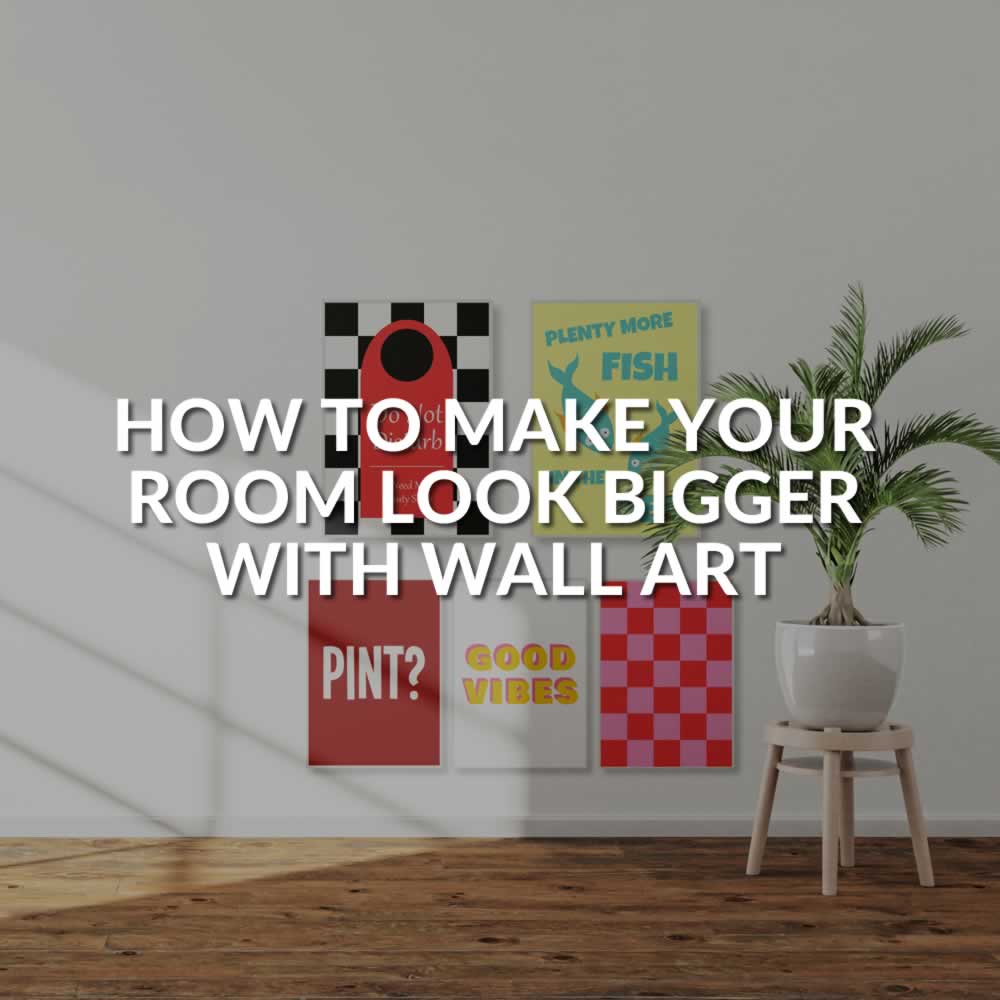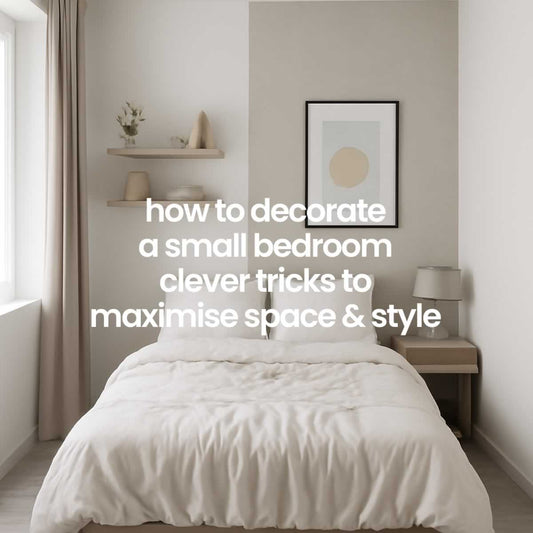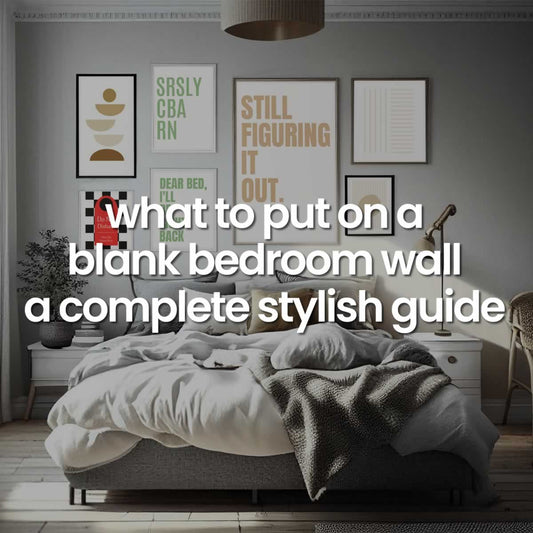Living in a small space doesn’t mean you have to compromise on style.
Here in the UK we're kind of used of having small rooms, right?
You can at least make the room look bigger, with lots of tricks, including your what you put on your walls.
With the right approach, wall art can play a significant role in making your room appear larger and more spacious.
Whether you’re decorating a cosy bedroom, a compact living room, or a narrow hallway, the right print and placement can create an illusion of depth and openness.
Here's how to make your room look bigger with wall art, with tips on choosing the right pieces, arranging them effectively, and using visual tricks to enhance your space.
Choosing the Right Wall Art for Small Spaces

Opt for Light and Bright Colours
The colours of your wall art can greatly influence the perception of space in a room.
Lighter tones and bright hues tend to make a space feel more open and airy, while dark, heavy colours can make it feel smaller and more enclosed.
-
Soft Pastels and Neutrals: Art featuring soft pastel colours or neutral tones like whites, beige, and light greys can reflect light and make the room feel more spacious.
-
Bright and Cheerful: Pieces with bright, vibrant colours can also add energy to a room without overwhelming it, especially if they’re balanced with plenty of white space in the artwork itself.
When it comes to choosing art for your home, these are key factors which should be considered.
Large Wall Art vs. Gallery Walls
The size of your artwork plays a crucial role in the visual impact it has on your room. Getting the right size wall art is paramount when it comes to your prints fitting in with your room.
Both large wall art and gallery walls can be effective in making a space feel bigger, but the key is in how you use them.
-
Large Wall Art: A single, large piece of art can create a focal point and draw the eye upwards, giving the impression of a larger space. When selecting large-scale art, opt for pieces with light colours or abstract designs that don’t overwhelm the room.
-
Gallery Walls: A well-curated gallery wall can also make a room feel bigger by creating a sense of movement and continuity. However, it’s important to maintain a cohesive theme and use frames that are consistent in colour or style to avoid a cluttered look.
Horizontal vs. Vertical Art
The orientation of your prints or posters can influence how the dimensions of a room are perceived.
-
Horizontal Art: Horizontal pieces, or landscape, can elongate a room, making it appear wider. This is particularly effective in narrow spaces like hallways or small living rooms.
-
Vertical Art: Vertical artwork or tall, narrow pieces can draw the eye upwards, giving the impression of higher ceilings and adding a sense of height to the room.
Strategic Placement of Wall Art

Hang Art at the Right Height
Hanging your print at the correct height is essential for creating a spacious feel.
Art that is hung too high or too low can disrupt the flow of the room and make the space feel disjointed.
-
Eye Level: A general rule of thumb is to hang artwork so that the centre of the piece is at eye level, which is typically about 145-155 cm from the floor. In smaller rooms, this can create a sense of balance and proportion.
-
Above Furniture: If you’re hanging art above furniture, such as a sofa or a bed, ensure the bottom of the frame is 15-20 cm above the furniture. This helps to integrate the art into the room without overwhelming the space.
Create Illusions with Mirrors and Art
Mirrors are a well-known trick for making a room look bigger, but when combined with wall art, they can be even more effective.
-
Mirrored Frames: Consider using prints with mirrored frames, which can reflect light and create an illusion of more space.
-
Art Near Mirrors: Placing prints near or opposite a mirror can double the visual impact of the piece, making the room feel larger and more open.
Use Diptychs and Triptychs
Diptychs (two-part prints) and triptychs (three-part prints) are excellent for small spaces.
These multi-panel pieces can spread across a wall, creating the illusion of a larger area.
The gaps between the panels add a sense of continuity and flow, which can make a room feel more expansive.
Visual Tricks with Wall Art

Embrace Minimalism
In smaller rooms, less is often more. Minimalist artwork, with plenty of white space or simple, clean lines, can create a sense of calm and openness.
-
Abstract Minimalism: Abstract art with soft lines and gentle curves can add interest without overwhelming the space. The key is to keep the design simple and the colours light.
-
Negative Space: Using negative space in your art - areas of the piece that are left blank or sparsely detailed—can make the art and, by extension, the room, feel larger.
Create Depth with Perspective
wall art that features perspective or depth, such as landscapes, cityscapes, or abstract designs with vanishing points, can create the illusion of a larger space.
These types of pieces draw the eye into the distance, making the room feel more expansive.
-
Wide Horizons: Landscape art with wide, open horizons can make a room feel broader, while images with paths or roads leading into the distance can add a sense of depth.
-
Architectural Elements: Art that includes architectural elements, such as doorways, arches, or staircases, can also give the illusion of added depth, as though the room extends beyond its physical walls.
Frame Selection
The frames you choose for your artwork can also impact the perception of space in a room.
We've already talked about how to frame your art, and selecting the correct frame can make a small room appear larger.
-
Thin, Light Frames: Thin, light-coloured frames create a clean, unobtrusive look that doesn’t dominate the artwork or the room. This can help keep the space feeling open.
-
Floating Frames: Floating frames, which create the illusion that the artwork is floating within the frame, can add a sense of depth and lightness to the piece, contributing to a more spacious feel.
Opt for Wall-Mounted Art
In small spaces, floor space is precious. By choosing wall-mounted art over standing art or sculptures, you free up floor space, which can make the room feel larger.
- Shelves with Art: Installing narrow shelves to display wall art and other decor items can also help keep the floor clear while adding visual interest to the walls.
On That Note
Making a small room look bigger with wall art is all about strategic choices.
By selecting the right colours, sizes, and orientations for your artwork, and placing them thoughtfully, you can create an illusion of more space and depth.
Whether you’re using large-scale pieces, gallery walls, or minimalist art, the key is to maintain balance and cohesion to avoid clutter.
Your small space can feel more open, airy, and inviting, making it a comfortable and stylish place to live.




